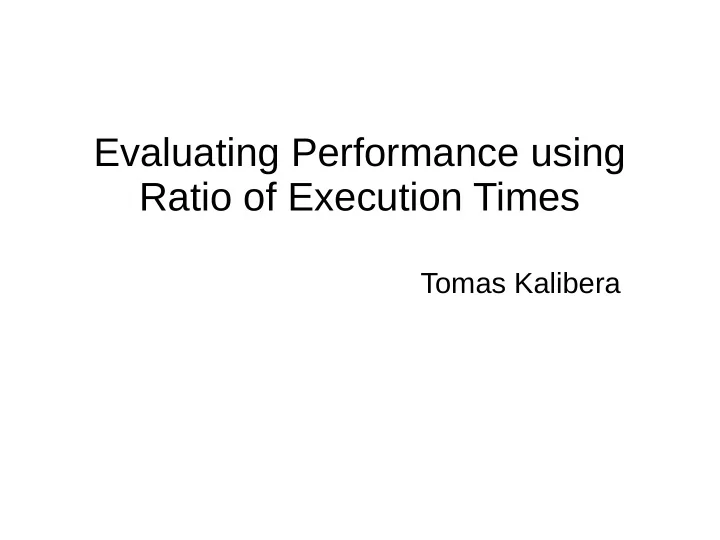

Evaluating Performance using Ratio of Execution Times Tomas Kalibera
My Background ● PL/Systems – R language: GNU R, (Purdue) FastR – Java: Ovm, OpenJDK – Garbage collection, interpretation, analysis ● Performance/Benchmarking – Methodology: modeling non-determinism – DaCapo benchmarks: observational study – Practice: DaCapo, SPEC CPU/JBB/JVM, Shootout, CD, CSIBE, FFT&kernels – Mono, Java, R – Teaching; Evaluate, Dagstuhl workshops
Talking about Performance (fictional conversations in PL/systems) Lunch at SW company Joe: Any numbers yet for your compiler patch? Ann: 9% on average, no big slowdowns. Joe: That's really good! Ann: Yes:) Or too good to be true, have to run more tests. Coffee at CS dept of a uni Cristine: How much slower is our VM than production VM X? John: Now within 2x. Cristine: Perfect, that allows us to claim our speedups are relevant. Dissertation (MSc) committee meeting, the student got 18% speedup on FFT with kernel patch and claimed he could speed up applications by 18% Erik: 18% speedup is far too small. We should reject. Tim: 18% is great even for just FFT, great work. The generalizing claim is naïve.
Evaluating Time Ratio In Papers Papers Reported Time Ratio 2011 ASPLOS 32 22 ISMM 13 9 PLDI 55 27 2015 ASPLOS 48 37 ISMM 12 10 PLDI 58 22 Total 218 127 ( 58% )
Important Decisions in Evaluations involving Time Ratio ● Which ratio? – Opinions, ratio games and confusion ● Averaging – Which mean, averaging over benchmarks ● Error estimate – Hardly ever any at all Warning: some options given in the following are questionable and some are outright wrong!
Time Ratio: But Which One? T old GNU-R, byte-code interpreter (B): 58s Purdue FastR (F): 16s T new (spectralnorm-alt4 [sn5] benchmark) Ratio of execution times T new 0.28 (28%) T old 1 − T new Percentage improvement in 0.72 (72%) execution time T old T old 3.63 (363%, 3.63x) Speedup T new T old “Percentage improvement 2.63 (263%) − 1 in speed” T new T old 1.38 (138%) SALE 250% T old − T new
Time Ratio: The Right Baseline? T B GNU-R, byte-code compiler (B): 58s T F Purdue FastR (F): 16s GNU-R, AST interpreter (A): 154s T A T F = 0.28 We reduced execution time to 28% of T B best performing alternative. We are 3.63x faster. T B = 3.63 T F T F T B We reduced execution time of an existing system = 0.10 = 0.38 T A T A to 10%. The best performing alternative reduced it to 38%. We are 9.63x faster but the alternative T A T A = 9.63 = 2.66 only 2.66x faster. T F T B
Summarizing over Benchmarks Language Shootout Benchmark Suite for R: n = 37 benchmarks. Execution times with FastR: T Fi Summarizing T A Execution times with GNU-R AST: ratio T Ai T F T Ai 1 n n ∑ i = 1 Arithmetic mean of ratios = 12.91 T Fi n ∑ i = 1 T Ai Ratio of sums = 7.00 n ∑ i = 1 T Fi √ ∏ i = 1 T Ai n Geometric mean of ratios n = 8.53 T Fi n = 5.02 Harmonic mean of ratios T Fi n ∑ i = 1 T Ai
What is Hiding Behind the Mean? √ ∏ i = 1 T Ai n Geometric mean of ratios n = 8.53 T Fi 66x speedup!
Repetition and Error Estimate Iteration times for sn5 (FastR) Percentile bootstrap 95% confidence interval for the mean cfsingle <- function (x) { means <- sapply (1:10000, function (i) mean(sample(x, replace = TRUE)) ) sort(means)[ c (250, 9750)] } Sn5 with FastR takes 16.6 ± 2.0s with 95% confidence.
Repetition and Error Estimate Percentile bootstrap 95% confidence interval for the ratio of means. Input: x – vector of iteration times for nominator Y – vector of iteration times for denominator cfratio <- function (x, y) { means <- sapply (1:10000, function (i) { xs <- sample(x, replace = TRUE) ys <- sample(y, replace = TRUE) mean(xs) / mean(ys) }) sort(means)[c(250, 9750)] } The speedup of FastR over GNU-R AST on sn5 is 9.4 ± 1.1x. FastR reduces execution time of sn5 over GNU-R AST to 10.8 ± 1.3%.
Repetition and Error Estimate Percentile bootstrap 95% confidence interval for the geometric mean.. Input: xr – vector of ratios (one for each benchmark, calculated as ratio of iteration means)) cfgmean <- function (xr) { gmean <- function (x) exp(mean(log(x))) gmeans <- sapply (1:10000, function (i) gmean(sample(xr, replace = TRUE)) ) sort(gmeans)[c(250, 9750)] } The geomean speedup of FastR over GNU-R AST is 8.9 ± 2.7x. On geomean, FastR reduces execution time over GNU-R AST to 12.4 ± 3.8%.
Summary ● Decisions for R study T new – Ratio for graphs T old T old – Ratio in text given as inverse T new – 95% bootstrap confidence intervals for ratios of individual benchmarks – Geometric mean over suite in text with huge disclaimer ● References ISMM'13, Rigorous benchmarking in reasonable time – OOPSLA'12, A black-box approach to understanding concurrency in DaCapo – VEE'15, A Fast Abstract Syntax Tree Interpreter for R – Uni of Kent technical report, https://kar.kent.ac.uk/30809, – Quantifying Performance Changes with Effect Size Confidence Intervals
Additional Resources Jain: The Art of Computer Systems Performance Analysis Lilja: Measuring Computer Performance: A Practitioner's Guide Kirkup: Experimental Methods: An Introduction to the Analysis and Presentation of Data NIST/SEMATECH: Engineering Statistics Handbook, http://www.itl.nist.gov/div898/handbook/ Wassermann: All of Statistics: A Concise Course in Statistical Inference Evaluate Collaboratory: Experimental Evaluation of Software and Systems in Computer Science, http://evaluate.inf.usi.ch/
Recommend
More recommend